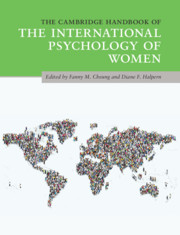Book contents
- The Cambridge Handbook of the International Psychology of Women
- The Cambridge Handbook of the International Psychology of Women
- Copyright page
- Dedication
- Contents
- Figures
- Tables
- Contributors
- Acknowledgments
- Section 1 The Underpinnings of Sex and Gender and How to Study Them
- Section 2 Developmental Perspectives of the International Psychology of Women
- Section 3 Cognitive and Social Factors
- Section 4 Work and Family Issues
- Section 5 Inequality and Social Justice
- Section 6 Health and Well-Being
- Epilogue Some Final Thoughts and Take-Home Messages
- Index
- References
Section 6 - Health and Well-Being
Published online by Cambridge University Press: 20 July 2020
- The Cambridge Handbook of the International Psychology of Women
- The Cambridge Handbook of the International Psychology of Women
- Copyright page
- Dedication
- Contents
- Figures
- Tables
- Contributors
- Acknowledgments
- Section 1 The Underpinnings of Sex and Gender and How to Study Them
- Section 2 Developmental Perspectives of the International Psychology of Women
- Section 3 Cognitive and Social Factors
- Section 4 Work and Family Issues
- Section 5 Inequality and Social Justice
- Section 6 Health and Well-Being
- Epilogue Some Final Thoughts and Take-Home Messages
- Index
- References
Summary

- Type
- Chapter
- Information
- The Cambridge Handbook of the International Psychology of Women , pp. 449 - 540Publisher: Cambridge University PressPrint publication year: 2020
References
Suggested Readings

Chu Kim-Prieto is a Professor of Psychology at the College of New Jersey. She was born in Korea and grew up in the USA. She earned her PhD at the University of Illinois, Urbana-Champaign. Chu teaches courses in psychology of emotion and happiness, research methods, and psychology of racism. Her research focuses on the effects of everyday emotions, as well as the effects of stereotypes and micro-aggressions.

Megan Heye earned her BA in Psychology, with a specialization in Biopsychology, at the College of New Jersey. She has conducted research on cognition throughout the aging process, and the relationship between emotions and micro-aggressions in the LGBTQ community, as well as between emotions and exercise. Currently, she is applying to doctoral programs for clinical neuropsychology.

Kai Mangino was born in China, but was adopted at a young age and grew up in New Jersey. She is a psychology student at the College of New Jersey. She is actively involved in the Bonner Community Scholars Program at the college along with her research in the psychology department. She has conducted research on the cognitive development of infants as well as studies analyzing the relationship between emotion and other factors such as exercise and LGBTQ micro-aggressions. Currently, she is completing her honors thesis on the effects of racial micro-aggressions on bystanders’ perceptions of stereotypes and modern-day racism attitudes. She will attend the University of Hartford for graduate school. She strongly identifies as an Asian American. She is also a feminist and tries to embrace a social justice mindset as she goes through life.
References
Suggested Readings

Gillian Eagle is a clinical psychologist and Professor in the Department of Psychology at the University of the Witwatersrand, Johannesburg. She lectures primarily in the field of clinical psychology. Her key research interest is the field of traumatic stress studies, with a particular focus on how traumatic stress responses are shaped by aspects of social identity and social context. She also has a strong interest in gender, violence perpetration, and masculinity. With Debra Kaminer she co-authored the book Traumatic stress in South Africa (2010). Eagle was born in Johannesburg and grew up in Pietermaritzburg, where she went through college and graduate school.

Susan Ayers was born in the USA and grew up in the UK. She is currently a psychologist and Professor at City University of London, in the Centre for Maternal and Child Health Research. Her research examines women’s perinatal mental health, in particular birth trauma, posttraumatic stress disorder, and high-risk groups such as parents who have preterm or stillborn babies. She is a founder of the International Network for Perinatal PTSD and author of Psychology for medicine (2010), and the Cambridge handbook of psychology, health and medicine (1997).

Charity Mkone is a registered clinical psychologist and Lecturer in the Department of Psychology at the University of the Witwatersrand, Johannesburg. She lectures primarily in the field of clinical interventions and community clinical practice. She has a particular interest in the intersection of gender, race, and class in shaping aspects of identity. She is currently completing research into the relationship between African fathers and their daughters.

Mapule Moroke is a counseling psychologist and Lecturer in the Department of Psychology at the University of the Witwatersrand, Johannesburg. She lectures primarily on social and community psychology. Her key research interests lie in the field of critical race, gender, class, and intersectionality experience of young adults and adolescents in contemporary South Africa. She also has a strong interest in violence, fear of crime, and masculinity.
References
Suggested Readings

Michelle J. Hindin is director of the Population Council’s Reproductive Health Program. Prior to joining she was Professor, Department of Population, Family, and Reproductive Health at the Johns Hopkins Bloomberg School of Public Health, where she continues to hold an adjunct appointment. She was also a scientist in WHO’s Reproductive Health and Research Department. She has published more than 115 peer-reviewed articles on topics ranging from contraceptive use to women’s empowerment. Hindin was born in the USA. She earned her PhD in Sociology at Johns Hopkins University and an MHS in the Department of Population Dynamics at the Johns Hopkins School of Hygiene and Public Health. She spent a semester in Brazil during her college years and did her doctoral research in Zimbabwe. She had a three-month consultancy in Rwanda, and worked extensively in a number of countries in sub-Saharan Africa.

Funmilola OlaOlorun is a Nigerian-born and trained community health physician. She grew up in both Nigeria and the United States. She has a PhD from the Department of Population, Family and Reproductive Health at the Johns Hopkins Bloomberg School of Public Health, Baltimore, MD. OlaOlorun is currently a Senior Lecturer in the Department of Community Medicine, College of Medicine, University of Ibadan, and an Honourary Consultant to the University College Hospital, Ibadan, Nigeria. Her main research interest is in women’s health across the life course, with a special focus on women’s empowerment and their reproductive health issues, especially family planning. OlaOlorun is also interested in gender-related issues, such as intimate-partner violence and how its experience influences the health and lives of women. She hopes that her career of teaching, research, and clinical practice helps to improve the health of Nigerian women and men, as well as the communities from which they come.
References
Suggested Readings

Chloe Parton is an Adjunct Fellow at the Translational Health Research Institute and School of Medicine at Western Sydney University. Her research interests are focused on women’s sexual and reproductive health, as well as gendered experiences of chronic illness, with a focus on cancer. Her doctoral research explored women’s negotiation and experience of sexual change after cancer. She is currently researching women’s experiences of motherhood while living with a chronic physical health condition. Parton was born and raised in Aotearoa New Zealand. She has spent a significant amount of her adult life as a migrant, having worked in Australia, Ireland, and the UK.

Jane Ussher is Professor of Women’s Health Psychology, Western Sydney University. She has published widely on the construction and lived experience of health, in particular women’s mental health, the reproductive body, and sexuality. She is editor of the Routledge “Women and Psychology” book series, and author of a number of books, including: The psychology of the female body (1989), Women’s madness: Misogyny or mental illness? (1991), Fantasies of femininity: Reframing the boundaries of sex (1997), Managing the monstrous feminine: Regulating the reproductive body (2006), and The madness of women: Myth and experience (2011). Ussher was born in the UK where she attended college and graduate school and now works in Australia. She identifies as lesbian.

Janette Perz is Professor of Health Psychology and Director of the Translational Health Research Institute at Western Sydney University. She researches in the field of reproductive and sexual health with a particular focus on gendered experiences, subjectivity, and identity. Perz has undertaken a significant research program in sexual and reproductive health, including the experience of premenstrual syndrome (PMS) in heterosexual and lesbian relationships; the development of and evaluation of a couple-based psychological intervention for PMS; sexual well-being and reproductive needs in CALD populations; and sexual and psychological well-being during menopause and midlife. Perz identifies as lesbian.

Lisa R. Rubin is an Associate Professor of Psychology and co-director of the Gender and Sexuality Studies Certificate program at the New School for Social Research in New York. She received her doctorate in Clinical Psychology from Arizona State University and was a postdoctoral fellow at Memorial Sloan Kettering Cancer Center before joining the New School faculty. Her scholarship is situated at the nexus of health psychology and psychology of gender and draws on interdisciplinary perspectives to examine processes of objectification and medicalization, and their influence on well-being. Her research spans and integrates work on body image, psycho-oncology, and assisted reproductive technologies. Rubin was born in northeast United States, where she grew up in an ethnically Jewish family and household. Attending graduate school in Arizona felt like going abroad to another country. She has traveled and experienced language immersion programs in Spain (Salamanca) and Guatemala.
References
Suggested Readings

Silvia Sara Canetto is Professor of Psychology at Colorado State University, Fort Collins, USA. She was born, raised, and educated in Italy where all her family still reside, and spent four years in Israel, where she received her MA in General Psychology from the Hebrew University of Jerusalem. She got her Doctor of Physiological Psychology from University of Padova, Italy, before completing her doctoral degree in Clinical Psychology and Gerontology from Northwestern University, USA. She is now an American as well as an Italian citizen. The United States is the exotic site of her critical studies of dominant “White” culture, and one of her homes. She speaks with an accent every language she knows: English, French, Spanish, Hebrew, and her native Italian, which makes her a stranger and a bit at home in a lot of places. Her research focuses on cultural scripts of gender and suicidal behavior, and on cultural scripts of gender, science, and engineering. She also investigates and writes about women’s human rights. She is a Fellow of the American Psychological Association (APA), the Association for Psychological Science, and the Gerontological Society of America; and the recipient of APA’s Denmark-Reuder award for outstanding international contributions to the psychology of women and gender.

Jiashun Chen is a graduate student in the School of Psychology at South China Normal University, Guangzhou. He was born in Guangxi Zhuang Autonomous Region, although he belongs to the majority Han ethnic group. He speaks three Chinese dialects fluently and has been learning English for twelve years. Having grown up in China, he brings insider perspectives to the Chinese experiences addressed in this chapter. Chen was a short-term scholar at Colorado State University, Fort Collins, USA, with mentorship by Professor Silvia Sara Canetto. During his time at CSU, he took her graduate class on women, men, and gender, and collaborated with her research team on a study of scripts of gender and suicide in China. These experiences expanded his view of gender, sexualities, culture, class, and beyond, scientifically and personally. His volunteer experience at LGBTQ+ NGOs in Guangzhou contributed to his understanding and commitment to preventing prejudice and marginalization.
References
Suggested Readings

Elizabeth K. Lefler has been an Associate Professor of Psychology at the University of Northern Iowa in Cedar Falls, since 2015. She was born in Nebraska where she earned her BA in Psychology from the University of Nebraska in Lincoln, and her MA and PhD in Clinical Psychology from Oklahoma State University in Stillwater. Lefler completed a pre-doctoral internship at the Kennedy Krieger Institute, Johns Hopkins School of Medicine in Baltimore, Maryland, and a postdoctoral fellowship at the Children’s Hospital of Philadelphia. Lefler’s research interests include the assessment of Attention-Deficit/Hyperactivity Disorder (ADHD) in understudied populations, as well as sex/gender differences in psychopathology. Lefler is the Director of the Psychological Assessment Clinic at the University of Northern Iowa, was honored to be a Fulbright Scholar in Kraków, Poland in 2017, where she taught child psychopathology courses to Polish university students at Uniwersytet Jagiellonski in Kraków.

Cynthia M. Hartung is a Professor of Psychology at the University of Wyoming in Laramie. She was born in Chicago, Illinois and attended college in Wisconsin. She earned her PhD in Clinical Psychology from the University of Kentucky in Lexington, and subsequently completed her internship at the University of Chicago Medical Center. Hartung then completed postdoctoral fellowships at the Oregon Health Sciences University in Portland and at the University of Denver in Colorado. Prior to beginning her position at the University of Wyoming in 2007, she was an Assistant Professor of Psychology at Oklahoma State University. Hartung is also an Adjunct Professor in Gender and Women’s Studies as well as the director of the University of Wyoming Psychology Clinic. Hartung’s research interests include sex and gender differences in psychopathology and the assessment and treatment of ADHD in adolescents and emerging adults with a focus on healthy lifestyle interventions. She is the author or co-author of more than 40 publications on these topics and has made numerous presentations regionally, nationally, and internationally.
References
Suggested Readings

Changming Duan is a cisgender Chinese woman born and raised in China until after college when she migrated to the United States. She received her master’s degree from Canada and her PhD in Counseling and Social Psychology from University of Maryland in the United States. She is currently a Professor of Counseling Psychology in the University of Kansas. Her research interests include addressing multicultural and social justice issues in counseling practice and training, understanding culturally specific counseling process and outcome, and using strength-based counseling to promote psychological healing and growth. She is also interested in international collaboration in research and training.

María del Pilar Grazioso was born in Ecuador and raised in Guatemala where she attended college. She studied for her master’s degree in the United States and her PhD in both the USA and Argentina. She carries a multicultural identity, with Italian ethnic background from her paternal side and Spanish, French, Belize, Cuban, and Guatemalan origins from her maternal side. She is recently retired from the Universidad del Valle de Guatemala (UVG) where she developed graduate programs in Counseling Psychology, Mental Health, and Community Psychology. Currently she co-coordinates Proyecto Aiglé, Guatemala, is affiliated to Fundación Aiglé Argentina, and is a research affiliate both at UVG and at Mayan Health Alliance Wuqukawoc. She received the APA Division 52 Outstanding International Psychologist Award and the Award Ricardo Bressani, and was recognized by the Colegio de Psicólogos de Guatemala. She has served in several leadership positions in the Interamerican Society of Psychology, and as associate editor of the Wiley-Blackwell Encyclopedia of gender and sexuality studies. Her interests focus on counseling and community mental health, multicultural training, psychotherapy, supervision, gender and prevention, and child and adolescent assessment. She is family oriented and enjoys baking, jogging, music, reading, and nature.

